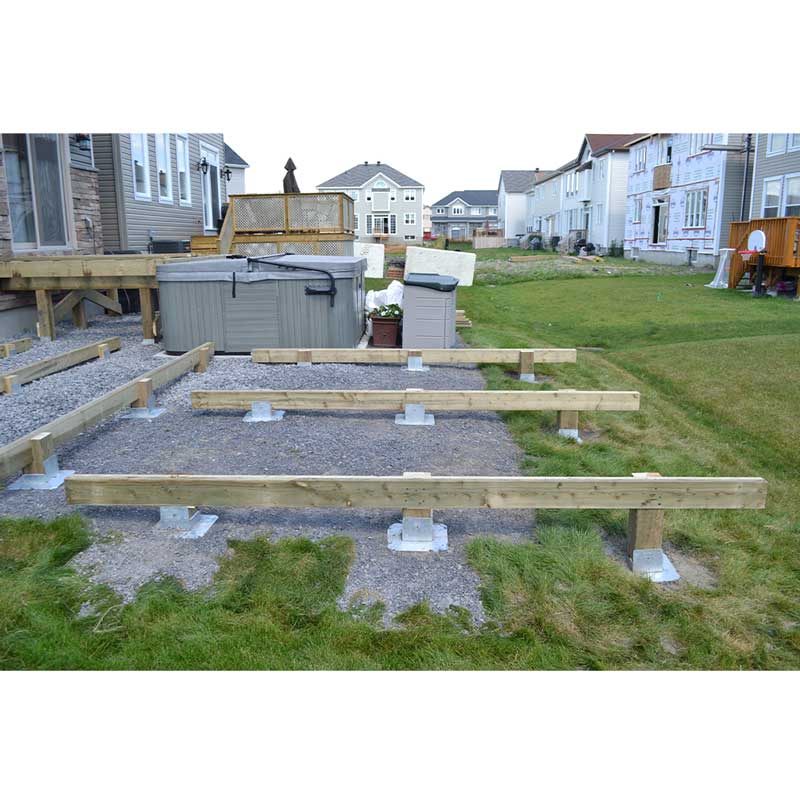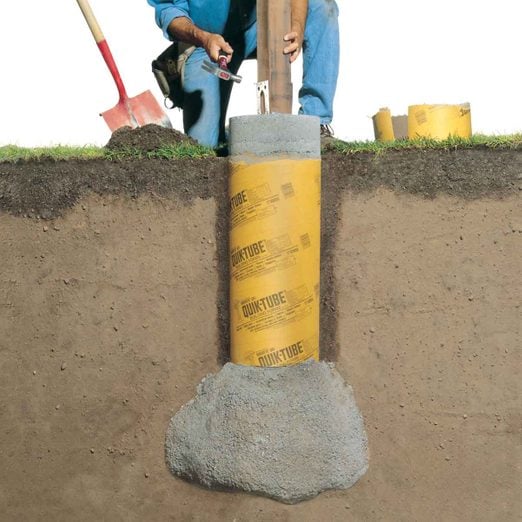Deck Footings 101: Browsing the Basics for a Secure and Durable Deck
Deck Footings 101: Browsing the Basics for a Secure and Durable Deck
Blog Article
Selecting the Right Deck Footings for Stability and Resilience
The long life and safety and security of your deck depend heavily on the type of footings you choose, as they provide the important assistance and stability to endure the examination of time. In this discussion, we will discover the various types of deck footings, think about the crucial factors to weigh when making a choice, and dive into the pros and disadvantages of different alternatives.
Kinds Of Deck Grounds
There are numerous kinds of deck grounds that can be utilized, each offering one-of-a-kind advantages and considerations. One common type of ground is the concrete pier footing. These grounds consist of a round hole loaded with concrete, which provides a strong foundation for the deck articles. Concrete pier footings are reasonably simple to install and supply excellent stability, making them a popular selection for numerous deck tasks.
These footings are set up by screwing them right into the ground, which produces a protected foundation for the deck. They also allow for easy modification and progressing of the deck if needed.
Alternatively, some building contractors go with precast concrete grounds. These grounds are made of durable concrete and be available in numerous sizes and shapes to fit different deck styles. Precast concrete footings are practical to mount and provide a secure base for the deck structure.
Lastly, another option is the post-in-anchor ground system. This sort of ground involves driving a steel support into the ground and affixing it to the deck post. It uses versatility in regards to positioning the deck posts and appropriates for decks with lightweight structures.
When selecting the best sort of deck ground, it is vital to think about elements such as soil problems, deck tons, and regional building regulations (Deck Footings). Consulting with an expert service provider or architectural designer can aid guarantee the proper ground is chosen for a secure and secure deck
Aspects to Take Into Consideration When Picking Grounds
When choosing the ideal grounds for a deck, it is important to very carefully take into consideration various elements such as soil conditions, deck load, and adherence to local building ordinance. These aspects play a considerable duty in making sure the stability and resilience of the deck structure.
The type of soil on which the deck will be constructed identifies the type of grounds needed. On the other hand, decks developed on clay or extensive dirts may call for grounds that can fit the dirt's propensity to broaden and agreement.
One more essential factor is the deck tons. The weight of the deck, including the products made use of and any potential online tons such as furnishings or celebrations, need to be taken into account when picking grounds. The grounds need to be designed to bear the weight of the deck and disperse it equally to stop any architectural issues or failings.
Lastly, adherence to neighborhood building regulations is vital. Building ordinance differ from area to area, and it is important to adhere to the specific needs set by the neighborhood authorities. Deck Footings. These codes make sure that the deck is built securely and meets the essential criteria for structural honesty and load-bearing capacity
Concrete Footings: Pros and Cons

Concrete footings supply a number of advantages and drawbacks when used as the foundation for a deck. On the favorable side, concrete grounds offer outstanding stability and toughness.
One more advantage of concrete grounds is their adaptability. They can be put into various shapes and sizes to suit various deck designs and configurations. Concrete footings can be tailored to fit the specific requirements and needs of the deck structure.
Nonetheless, there are additionally some downsides to making use of Continue concrete footings. One major downside is the cost and labor involved in their setup. Concrete grounds need excavation discover this and often require the aid of heavy machinery. This can boost the total expense of the deck project and might need expert aid.

Helical Piers Vs. Sonotubes: Which Is Better?
In taking into consideration the foundation options for a deck, the contrast between helical piers and sonotubes is vital in determining the superior option. Helical piers, also referred to as screw piles, are steel shafts with helical plates affixed to them. They are turned into the ground making use of hydraulic equipment, providing a sturdy and stable foundation for the deck. On the other hand, sonotubes are round forms constructed from cardboard or fiber product that are full of concrete. They are placed in an opening dug into the ground and give support for the deck.
The helical plates on the piers produce a strong grip with the soil, changing or avoiding any kind of motion of the deck. Sonotubes, on the other hand, depend only on the concrete filling up for stability, which might not offer the same level of strength and resistance.
In regards to setup, helical piers are fairly less complicated and faster to mount contrasted to sonotubes. The hydraulic machinery used to turn the piers right into the ground guarantees a reliable and quick process. Sonotubes, on the various other hand, call for digging holes and putting concrete, which can be labor-intensive and time-consuming.
Additionally, helical piers are a more versatile option. If required, they can be utilized in different soil conditions and can be adjusted or reinforced. Sonotubes, on the other hand, might call for additional support, such as rebar, in specific dirt conditions or areas with high tons needs.
Selecting the Right Footings for Your Deck's Dimensions
For ideal structural honesty, it is necessary to thoroughly select the suitable grounds that line up with the dimensions of your deck. The measurements of your deck, including its length, size, and elevation, play a substantial role in figuring out the type and size of grounds required.
When picking grounds for your deck, it is important to take into consideration the load-bearing ability of the soil. The weight of the deck, combined with the weight of any type of furnishings or individuals on it, applies a substantial pressure on the grounds (Deck Footings). It is vital to select footings that can over here sufficiently support this weight without moving or sinking over time.
The dimension and shape of the grounds ought to likewise be taken into consideration. Bigger decks with higher dimensions call for bigger footings to give adequate security and assistance. The form of the footings, whether they are square or round, depends on the layout and design of the deck. Additionally, the depth at which the grounds are installed need to be determined based on the frost line in your region to avoid any heaving or moving due to freezing temperatures.
Conclusion
In final thought, selecting the best deck footings is important for ensuring security and longevity. Variables such as the sort of grounds, the deck's measurements, and the pros and cons of various alternatives should be thought about. Concrete grounds supply stamina and longevity, yet may be more pricey and taxing to mount. Helical piers and sonotubes have their very own benefits and downsides. Inevitably, picking the suitable footings for your deck's certain demands is essential for a successful and long-lasting structure.
These footings are composed of a round hole filled up with concrete, which gives a solid foundation for the deck posts. Concrete pier footings are relatively simple to set up and provide outstanding stability, making them a preferred option for lots of deck tasks.
Precast concrete grounds are convenient to install and give a stable base for the deck structure.
It offers adaptability in terms of positioning the deck blog posts and is appropriate for decks with light-weight structures.
Concrete footings supply several benefits and negative aspects when utilized as the structure for a deck.
Report this page